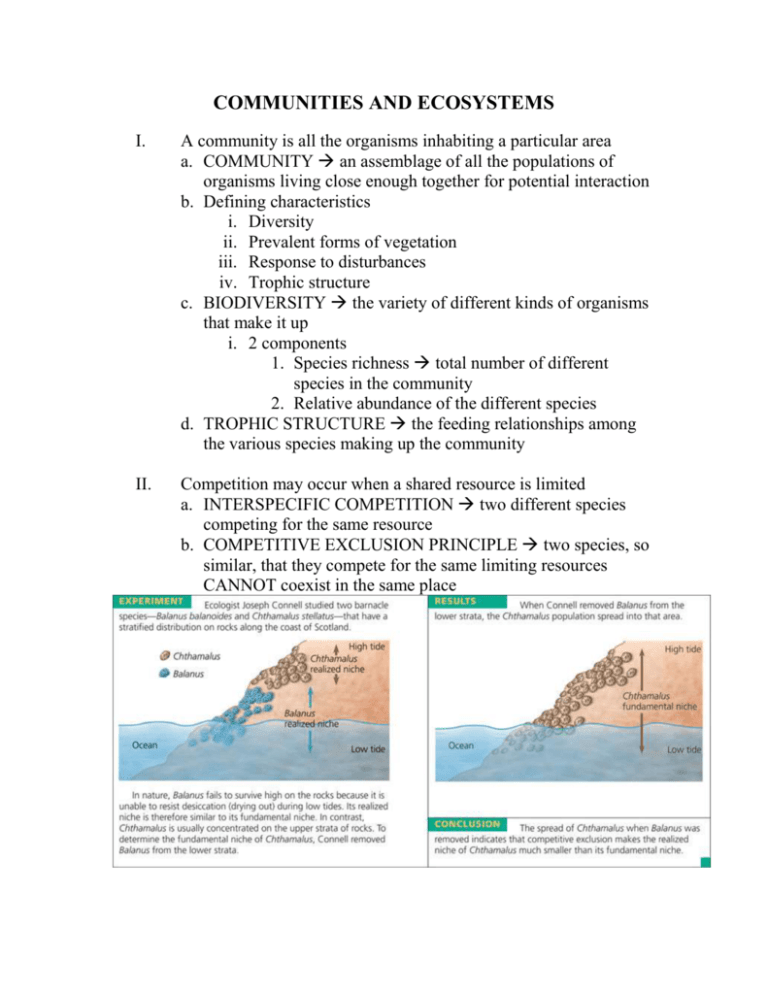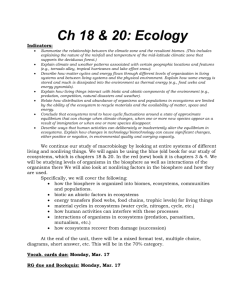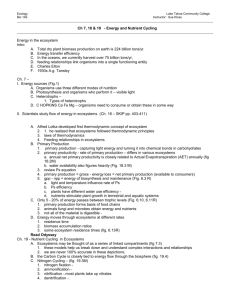COMMUNITIES AND ECOSYSTEMS
advertisement

COMMUNITIES AND ECOSYSTEMS I. A community is all the organisms inhabiting a particular area a. COMMUNITY an assemblage of all the populations of organisms living close enough together for potential interaction b. Defining characteristics i. Diversity ii. Prevalent forms of vegetation iii. Response to disturbances iv. Trophic structure c. BIODIVERSITY the variety of different kinds of organisms that make it up i. 2 components 1. Species richness total number of different species in the community 2. Relative abundance of the different species d. TROPHIC STRUCTURE the feeding relationships among the various species making up the community II. Competition may occur when a shared resource is limited a. INTERSPECIFIC COMPETITION two different species competing for the same resource b. COMPETITIVE EXCLUSION PRINCIPLE two species, so similar, that they compete for the same limiting resources CANNOT coexist in the same place c. NICHE a species’ role in its community, or the sum total of its use of the biotic and abiotic resources of its habitat d. RESOURCE PARTITIONING the differentation of niches that enables similar species to coexist in a community III. Predation leads to diverse adaptations in both predator and prey a. PREDATION an interaction where one species eats another b. PREDATOR the consumer c. PREY the food species d. PARASITISM a parasite lives on, or in, its host and obtains its nutrition from the host; may be considered a form of predation e. COEVOLUTION a series of reciprocal adaptations in two species f. BATESIAN MIMICRY a palatable or harmless species mimics an unpalatable or harmful model g. MULLERIAN MIMICRY two unpalatable species that inhabit the same community mimic each other IV. Predation can maintain diversity in a community a. KEYSTONE SPECIES a species that exerts strong control on community structure because of its ecological role, or niche V. Symbiotic relationships help structure communities a. SYMBIOTIC RELATIONSHIPS an interaction between two or more species that live together in direct contact i. PARASITISM ii. COMMENSALISM one partner benefits without significantly affecting the other iii. MUTUALISM benefits both partners in the relationship VI. Disturbance is a prominent feature of most communities a. DISTURBANCE events such as storms, fire, floods, droughts, overgrazing, or human activities that damage biological communities, remove organisms from them, and alter the availability of resources b. ECOLOGICAL SUCCESSION transition in a species composition in a community c. PRIMARY SUCCESSION a community arises in a virtually lifeless area with no soil d. SECONDARY SUCCESSION when a disturbance has destroyed an existing community but left the soil intact e. CLIMAX COMMUNITY a permanent final stage in succession; mature, stable communities that will persist indefinitely VII. Ecologist Frank Gilliam discusses the role of fire in ecosystems a. Not all fires are bad b. They help to maintain the appropriate biome that ensures biological diversity and stability VIII. Energy flow and chemical cycling are the two fundamental processes in ecosystems a. ECOSYSTEM a biotic community and the abiotic environment with which it interacts b. ENERGY FLOW the passage of energy through the components of the ecosystem c. CHEMICAL CYCLING the circular movement of materials within the ecosystem d. *Energy flows in and out, whereas chemicals are recycled IX. Trophic structure is a key factor in ecosystem dynamics a. TROPHIC STRUCTURE a pattern of feeding relationships b. FOOD CHAIN the sequence of food transfer from trophic level to trophic level c. PRODUCERS the trophic level that supports all others, consists of autotrophs d. PRIMARY CONSUMERS herbivores; consume (eat) plants e. SECONDARY CONSUMERS tiny carnivores f. TERTIARY and QUATERNARY CONSUMERS large carnivores g. DETRITIVORES derive their energy from detritus i. DETRITUS dead material produce by all trophic levels h. SCAVENGERS vs DECOMPOSERS i. DECOMPOSERS the breakdown of organic materials to inorganic ones X. Food chains interconnect, forming food webs a. FOOD WEB a network of interconnecting food webs XI. Energy supply limits the length of food chains a. BIOMASS the amount, or mass, of living organic material in an ecosystem b. PRIMARY PRODUCTION the amount of solar energy converted to chemical energy (organic compounds) by an ecosystems autotrophs during a given time period c. RULE OF 10 only 10 % of energy is passed to next trophic level XII. A production pyramid explains why meat is a luxury for humans a. Humans must eat more meat to obtain the same amount of energy that can be obtained from an equivalent amount of plants XIII. Chemicals are recycles between organic matter and abiotic reservoirs a. ABIOTIC RESERVOIRS the part of the ecosystem where a chemical accumulates or is stockpiled outside of living organisms XIV. Water moves through the biosphere in a global cycle XV. The carbon cycle depends on photosynthesis and respiration XVI. The nitrogen cycle relies heavily on bacteria XVII. The phosphorous cycle depends on the weathering of rock XVIII. Ecosystem alteration can upset chemical cycling XIX. David Schindler talks about the effects of nutrients on freshwater ecosystems a. EUTROPHICATION adding nutrients in ponds and lakes causes photosynthetic organisms to rapidly multiply XX. Zoned reserves are an attempt to reverse ecosystem disruption a. ZONED RESERVES is an extensive region of land that includes one or more areas undisturbed by humans











